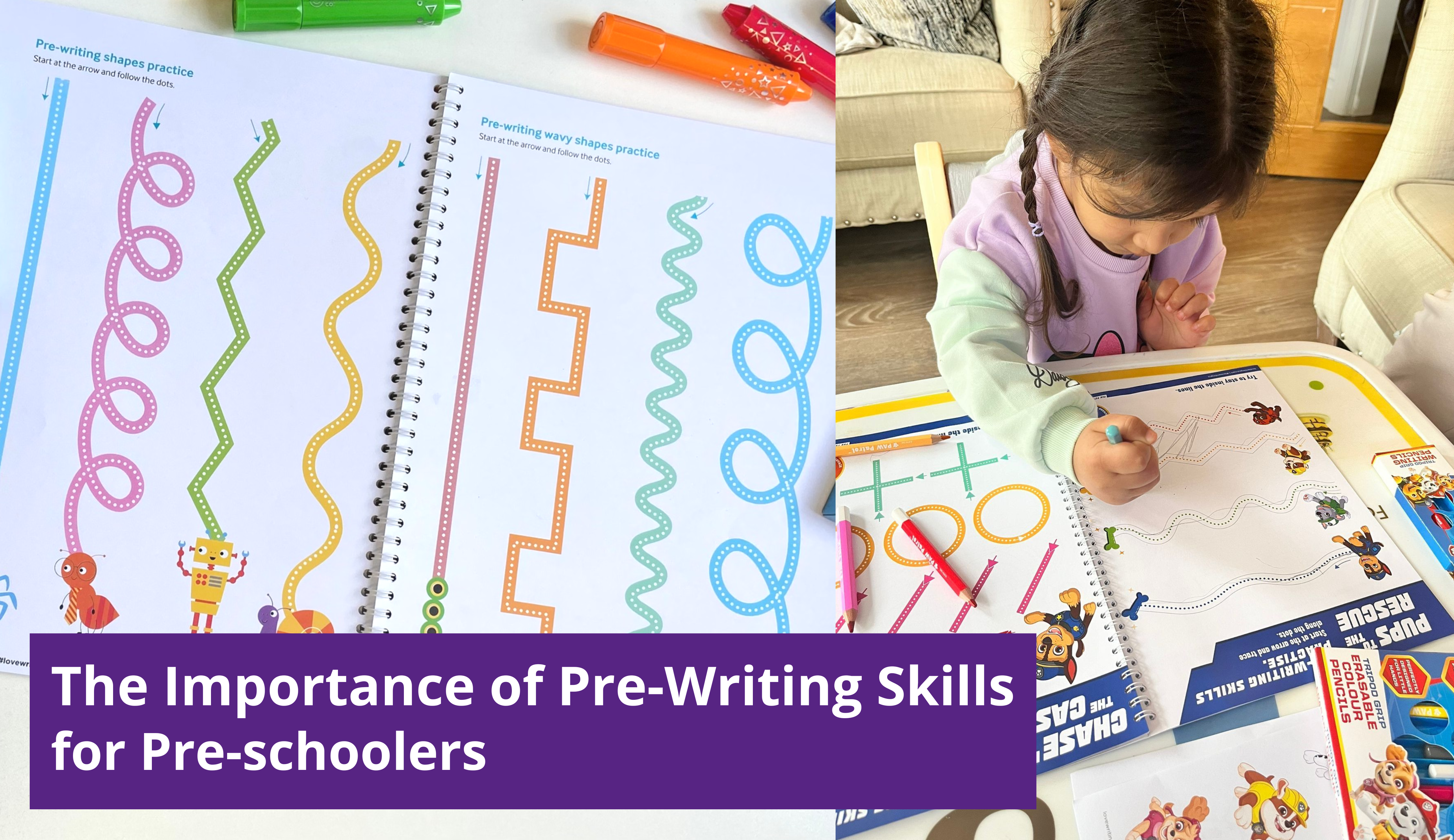Did you know that 10% of the world's population writes with their left hand? Learning how to write can be a difficult process and often even more so when left-handed. There are several techniques, hints and tips that you can incorporate in everyday writing life to help teach left-handed children to write.
We know how important it is to start off on the "right foot" from the beginning of every child's handwriting journey as not doing so may lead to difficulties such as poor pencil control, muscle fatigue and excessive smudging in the future that lead to reluctant writing.
So, we've put together our Top 10 Useful Tips to help your left-handed child get to grips with writing from the start.
Let's get started!
In this blog, you will find:
1. Position the paper correctly.
2. Use an inclined surface
3. Use the right hand for stability.
4. Keep the wrist below the line to avoid the ‘hook’ hand.
5. Build fine motor skills
6. Hold the pencil in the right place.
7. Practise the tripod grip.
8. Sit lefties on the left.
9. Use the correct tools.
10. Use writing practice sheets.
Here at Love Writing Co. we have expertly designed all of our handwriting practice resources to be suitable for right and left handers.
Do you need more tips? Join Love Writing Co. on a Left-Handed Learning Adventure! Get your essential FREE left handed tips guide for more top tips, expert advice and fun activity ideas to spur your little leftie on a magical learning to write journey!
Subscribe to our newsletter here to access all of your learning ideas, tips & free handwriting practice activity sheets. Exclusive offers await you!
1. Position the paper correctly (so important!)
When your child sits down to practise their handwriting, position their paper slightly to the left of the centre, and rotate roughly 45 degrees clockwise (moving the top right corner down slightly). This makes it easier for your child to see the nib of the pencil as they're writing and avoid the frustrations of smudging their work.
Take a look at these examples below to help (insert images of paper in wrong then the correct position)
Top Tip: Our handwriting practice workbooks support the UK National Curriculum and include a special ring binder so they lay flat on a desk and can be tilted to the side for easier left handed handwriting practice. Shop our award winning Handwriting Practice Workbooks here now!
- Use an inclined surface
Working on an inclined surface can be helpful for left handers to help improve their fine motor skills and wrist movement. Slant boards prevent the flexed/hooked wrist that typically develops for left handers. Slant boards are available to buy online or simply use a lever arch file to create an elevated surface.
Position the paper correctly and stick down with some tape or paper clips to keep it from shifting around as they learn to write. Once your child is comfortable and confident enough to position their paper and hands correctly you can then remove the tape and incline.
- Use the right hand for stability.
Have your child place their right hand flat on the right side of their paper for stability. This helps your child to keep their paper in the correct position, improves their posture, balance and coordination skills.
Comfort and stability is an important factor when learning to write. That's why our Tripod Grip Handwriting Pencils are uniquely designed with a hexagonal grip, wider diameter and the correct length to fit perfectly in a child's hand.
Benefits of our pencils;
- Develop the correct tripod grip
- Write more often
- Learn to write in comfort
- Apply less pressure
- Softer core
- Prevents muscle fatigue
- Improves fine motor skills
- Build muscle memory
- Fun and engaging colours
Available in Ages 3-5 & 6-9, Try our Tripod Grip Handwriting Pencils here
4. Keep the wrist below the line to avoid the ‘hook’ hand.
Without guidance, left-handed writers often develop an uncomfortable ‘hooked’ wrist position. This is where your child might begin to curve their wrist in order to see the tip of their pencil and not smudge any of their brilliant ideas! It is important to encourage your child to keep the pencil on the line, with the wrist below the line to improve their vision, reduce arm strain and prevent smudging.
To avoid the ‘hook’ hand, teach your child to position their paper correctly and work on their pencil grip and control skills. Our Handwriting Practice Activity Workbooks are all specially ring-binded in order to allow left-handers to comfortably lay each page flat to complete & perfectly paired with our Tripod Grip Writing Pencils. Click here to shop our Handwriting Practice Bundles now!
- Build fine motor skills
For left-handed children to learn to write comfortably, confidently and with ease it's very important to develop fine motor skills to strengthen their fingers and improve wrist movement. We can improve fine motor skills through arts, crafts and mark making activities so get your pens and pencils at the ready and let's get creative!
Why not try our Love Writing Co. 3-in-1 Fine Motor Washable arty Crayons? Drawing, colouring and writing is a joy with our easy-glide Washable Arty Crayons, especially developed to fit a child’s hand. 12 vivid colours that can be used as crayons, watercolours or pastels that will unleash your child's self expression and turn learning to write into a fun colourful magical adventure!
6. Hold the pencil in the right place.
Ideally left-handers should hold the pen or pencil roughly 2-3 cm from the point to enable them to see their writing and avoid ‘hooking’ with the writing hand or adopting awkward neck posture when writing.
Indicate where they should hold the pencil with a marker line or a small elastic band wrapped around the desired area, which can be removed once the child is familiar with the position.

7. Practise the tripod grip.
Show your child how to hold their pen/pencil with the correct tripod grip. This is where the thumb, index and middle fingers work together allowing small coordinated movements. The correct pencil grip, taught during the early stages along with sitting and paper position, should eliminate the ‘hooked’ hand problem.

For even more helpful tips on teaching your little leftie to learn to write and in the correct tripod grip, Click here and get your FREE essential left-handed handwriting tips guide.
Developed to be the correct length with a wider diameter, softer core, our pencils prevent muscle fatigue whilst encouraging the correct tripod grip from the very first use, promoting a love of writing from an early age. Click here to shop now and see why 1000’s of parents choose our handwriting pencils and workbooks everyday!
Edith told us:
‘’Thanks to Love Writing Co. my (4yo) nephew who is left-handed can now hold his pencil in the correct tripod grip. I’m so proud of him and cannot recommend these pencils enough, Thank you again!”
Another Proud Parent told us:
“Pencils are fab & really easy to use. I bought them for my son who is left handed & struggles with writing. He is really enjoying using them!”
8. Sit lefties on the left.
It is important for left-handers to feel comfortable and have enough space to write. If you’re helping more than one child with their handwriting practice or homework, be sure the left-handed child is sitting on the left to avoid their elbows clashing as they write.
9. Use the correct tools.
When children start writing, it is far easier to use soft leaded pencils rather than pens to reduce pressure and avoid smudging. Pencils with broader and softer leads (2B rather than HB) help to reduce writing pressure. Pencils with a hexagonal grip and wider diameter are well-suited to left-handers as they encourage the correct tripod grip.
Love Writing Co. Pencils are especially designed for little hands and suitable for right and left-handers. You can buy them here combined with our Handwriting Practice Workbooks that support the UK National Curriculum and so many more award winning handwriting practice resources for children.
Here at Love Writing Co. we have expertly designed all of our handwriting practice resources to be suitable for right and left handers. Embark on a delightful journey of discovery and fun with our specially curated Left-Handed Learning Adventure Pack, designed with your little lefty in mind! Tailored for children aged 3-5, this comprehensive bundle is your all-in-one solution to kickstart the joy of learning to write, draw, and express creativity with ease and confidence.
Available in Ages 3-5 & 6-9, Try our Left-Handed Writing Packs here
10. Left-handed Handwriting Practice Activity Sheets.
By using fun-filled handwriting practice activity sheets with fun characters and rewards throughout is a great way to encourage your child to enjoy learning to write. Children often will feel greater encouragement and consider practising their handwriting skills as a fun activity rather than a boring task. Click here to shop our digital download Handwriting Practice Activity Sheets for kids. Practice pencil grip and control, learn to write the alphabet and fun colouring activities to keep them entertained for hours!
Unlock the joy of writing for your little learner with 56 Pages of paw-some learning adventures with Paddington™ x Love Writing Co. This Paddington themed handwriting and alphabet practice workbook lays the foundation for early learning and creates a fun, engaging and positive outlook to learning to write. With a lay-flat and ring bound design, making it perfect for right and left-handed little learners.
Our Paddington™ workbook has focused pencil control and writing activities introducing the alphabet in a simple format whilst helping your child learn letter and word formation, maths, phonics, reading and much more. PAW-fectly paired with our Tripod Grip Writing Pencils and Erasable Tripod Grip Colour Pencils will allow you to erase and re-use several times. Click here to shop the NEW Paddington™ collection now!
We hope you've found this helpful and if you are looking for more hints, tips and tricks for handwriting for early learners (left and right-handers) then be sure to subscribe to our newsletter here
Be kept up to date with regular advice and lots of exclusive and handwriting practice sheets including 6 FREE activity worksheets when you sign up to our newsletter!
We'd love to hear from you and see how you’re little lefties are getting on with their handwriting practice
Join our Love Writing Co. family @lovewritingco and don’t forget to snap, tag and share with us all of your brilliant handwriting practice and art masterpieces. Happy Writing!
Love from all of us at Love Writing Co.
All images within this blog are created & strictly owned by Love Writing Co. only.











Leave a comment
All comments are moderated before being published.
This site is protected by hCaptcha and the hCaptcha Privacy Policy and Terms of Service apply.